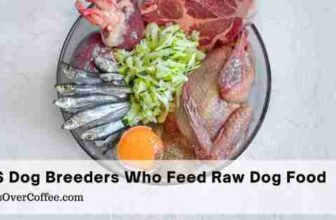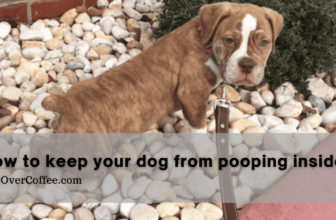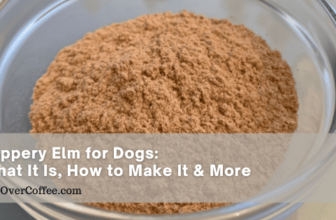
Readers usually ask me how to do an elimination diet for dogs when they suspect that their pups struggle with one or several raw dog food ingredients.
While another option is to use a dog food allergy test, that one is more expensive, albeit quicker.
So instead of answering all reader e-mails about food elimination diets for dogs separately, today I’ll share what I know about it here on the blog, including:
- What it is in the first place
- Its benefits, and
- How to do it.
First Things First: What Is An Elimination Diet For Dogs?

Disclaimer: This blog post contains affiliate links. I may earn compensation when you click on the links at no additional cost to you.
Well, when you implement an elimination diet for your raw-fed dog, you are systematically identifying and managing potential food sensitivities or allergies.
In this approach, you remove potential allergens from your dog’s diet and replace them with novel ingredients.
During the elimination phase, you feed your dog a limited diet that consists of a novel protein source.
This allows your dog’s digestive system to rest and helps alleviate symptoms related to food sensitivities.
In the reintroduction phase, you gradually reintroduce eliminated ingredients one at a time, and watch out for adverse reactions or symptoms to identify specific allergens.
The ultimate goal of a food elimination diet for dogs is to pinpoint problematic foods and create a customized diet for your pup.
Note that this approach doesn’t take any environmental sensitivities into consideration.
For example, dust mites, pollen or cigarette smoke.
Benefits Of A Food Elimination Diet For Raw-Fed Dogs

A food elimination diet for dogs has several benefits:
Identifies Food Sensitivities
The primary goal is to pinpoint specific ingredients that cause adverse reactions in your dog.
Provides Symptom Relief
An elimination diet for dogs helps provide relief from various digestive problems, skin issues, and behavioral changes.
Allows For A Customized Diet
Once you’ve identified the trigger foods, you can put your pup’s custom homemade raw dog food diet together.
Supports Improved Digestive Health
The elimination phase gives your dog’s digestive system a break from potential irritants, which helps promote healing and reduces inflammation.
Helps Prevent Chronic Conditions
If you identify and manage food sensitivities in your pup early on, you can help prevent the development of chronic health conditions.
Helps Increase Energy and Vitality
A customized diet free from allergens can contribute to increased energy levels and overall vitality in your dog.
Enhances Coat and Skin Health
Resolving food sensitivities helps make your dog’s coat shinier and their skin healthier.
You can expect less itching, redness, and flakiness.
Supports A Better Weight Management
By tailoring the diet to your dog’s specific needs, it can contribute to maintaining a healthy weight and preventing obesity-related issues like arthritis.
Common Signs And Symptoms Of Food Sensitivities In Dogs
Not sure if your raw-fed dog could benefit from a food elimination diet?
Take a look at the common symptoms I’m listing below.
If you notice more than two in your pup on a regular basis, they’re probably a candidate for an elimination diet.
- Digestive Issues:
- Vomiting: Frequent vomiting can indicate a sensitivity to certain ingredients.
- Diarrhea: Loose stools or diarrhea can be a sign of gastrointestinal distress.
- Flatulence: Excessive gas may result from difficulty digesting certain raw dog food ingredients.
- Skin Problems:
- Itching and Scratching: Persistent itching, scratching, or licking, especially around the paws, ears, or rear end.
- Redness or Inflammation: Skin redness, inflammation, or hot spots.
- Hair Loss: Allergic reactions can lead to hair loss.
- Ear Infections:
- Ear Scratching: Dogs with food sensitivities often show increased pawing or scratching at their ears.
- Discharge or Odor: Ear infections may result in foul-smelling discharge or redness.
- Gastrointestinal Distress:
- Abdominal Pain: Dogs may exhibit signs of discomfort and may not want to be touched on their belly.
- Behavioral Changes:
- Agitation or Restlessness: Dogs with food sensitivities may display increased agitation or restlessness.
- Lethargy: On the other hand, some dogs may become lethargic or show a decrease in activity levels.
- Chronic Ear or Skin Infections:
- Recurrent or persistent ear infections and skin issues, such as rashes or sores, may signal an underlying food sensitivity.
- Weight Loss:
- Unexplained weight loss, despite a balanced raw dog food diet, can be a sign of malabsorption or digestive issues related to food sensitivities.
How To Do An Elimination Diet For Dogs
OK, now that you understand the benefits of a food elimination diet for dogs and which symptoms to look out for, here’s how to pull it off.
1. Write Down Everything Your Dog Currently Eats
This applies both to homemade raw dog food diets as well as to commercial raw diets.
You’ll also want to include any treats and supplements you give your dog.
Exclude any ingredients on that list from your dog’s diet for the next 6 weeks.
2. Choose A Novel Protein Your Dog Hasn’t Had Before
Then feed that protein for 6 weeks as a base diet.
One option is to source different cuts of meat from that protein and make your own raw meals.
Or you can buy premade raw meals that only consist of that one protein source.
The following three raw dog food retailers in the US offer meals made of single protein sources:
Now, this is going to be different for each dog and really depends on what they’ve eaten up to that point.
For example, if your dog has only had chicken, beef, and lamb, you could choose rabbit, duck, venison, or goat.

Your dog’s health should drastically improve within those 6 weeks.
If it doesn’t and the opposite happens, they’re likely allergic to that protein as well.
In that case, pick a different protein source. You don’t have to wait 6 weeks to pick a different protein source!
Also, make sure that any treats that you give your dog are only made of the novel protein.
These types of treats are known as single-ingredient treats and are easy enough to find.
For example, on Amazon, one of the 3 raw dog food retailers I mentioned, or at a well-stocked, independently-owned pet retail store.
The picture below features my pup Wally with a Bison liver dog treat from Montana Dog Food.

3. Reintroduce The Old Ingredients One By One
Really take your time with this one if you want reliable results.
That said, add each ingredient to the base mix for 2 weeks.
If you notice that your dog suddenly starts having health issues again, omit the ingredient and wait a week before you add another ingredient.
Once you add the next old ingredient, see how your pup does with it, and either keep it or omit it.
Repeat until you’ve tested all old ingredients.
It’s really important to monitor and document any changes in your dog’s health and behavior during the elimination phase!
Note: If you didn’t feed any oily fish as part of your old ingredients, now is a good time to add different types of fish and see which ones work for your pup.
Oily fish is rich in Omega-3 fatty acids that help support healthy skin and a shiny coat.
Read all about raw fish for dogs here.

How To Do An Elimination Diet For Dogs: Bottom Line
The most important thing to keep in mind is that this approach takes a while, so please be patient!
You’ll start by making a list of everything your dog currently eats.
Then you omit all of those ingredients and pick a novel protein your pup hasn’t had before.
Next, feed that protein as a base mix for 6 weeks to allow your dog’s system to reset itself.
If your pup does well with it, add the old ingredients back into your dog’s diet, one by one. Feed each old ingredient for 2 weeks.
Also, remember to keep a detailed journal of your dog’s diet and their symptoms as you omit/reintroduce ingredients.
Common Mistakes to Avoid During An Elimination Diet for Dogs
- Rushing through the elimination diet
- Not eliminating all potential allergens
- Introducing old foods too quickly during the reintroduction phase
If you follow all of these steps, you’ll eventually figure out which raw dog food ingredients agree with your dog!
Related Reading
(Visited 4 times, 1 visits today)







